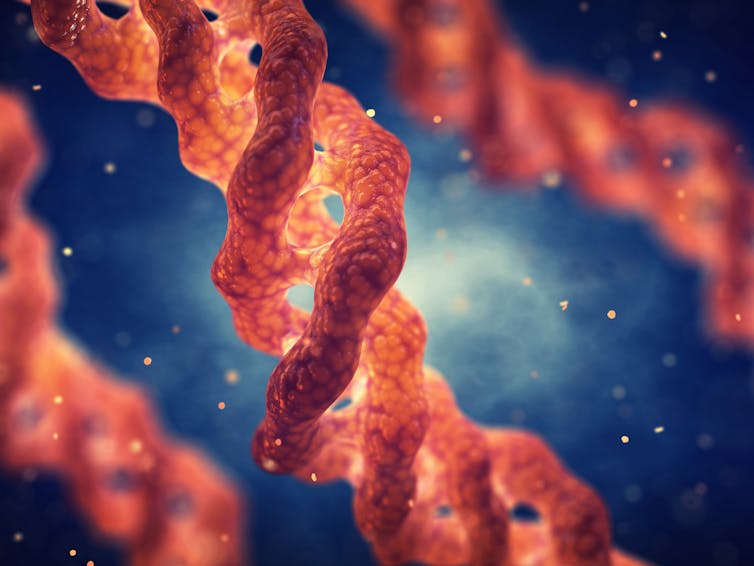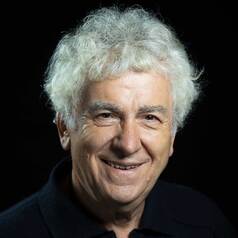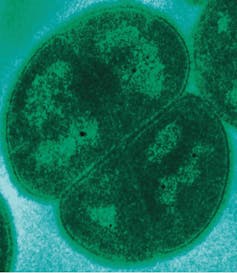Existing theories on the chemistry of ageing are being turned on their head, thanks in particular to a small ultra-resistant bacterium capable of “coming back to life” after extremely harmful attacks.
This is Deinococcus radiodurans, one of the most resistant bacteria known to date, which lives in arid environments such as desert sand. It survives in canned meat after the “shock” treatment of gamma radiation sterilisation. It can also overcome an irradiation dose 5,000 times greater than the lethal dose for humans.
Deinococcus radiodurans is an extremophilic bacterium and one of the most radiation-resistant organisms known. Here it is seen by transmission electron microscopy. Michael Daly, Uniformed Services University, US Department of Energy
Studies have shown that this bacterium survives even if its DNA is damaged and broken into several hundred fragments as a result of violent stress. In just a few hours, it reconstitutes its entire genetic make-up and returns to life. Its DNA isn’t resistant, it’s simply repaired immediately by proteins that are indestructible in the face of this extreme radiation.
Hence the secret of the robustness of this extremophilic bacterium depends on the robustness of its “proteome” – the sum of all its proteins – and in particular its DNA repair proteins.
This suggests a new paradigm: to increase longevity, particularly in humans, it is the proteome – rather than DNA – that we need to protect.
An organism’s survival depends on the activity of its proteins. If we act against the alteration of the proteome, which is at the root of ageing, we are simultaneously acting on all its consequences: for example, cell survival and function; and we are avoiding mutations induced by radiation.
The keys to ageing
Ageing is characterised by the accumulation of events that deteriorate the functions of our organs and, as a consequence, there’s an exponential increase in the risk of death and disease over time.
Numerous models have been proposed to explain the molecular basis of ageing, such as the theory of cellular senescence, the reduction in DNA repair capacity, telomere shortening, mitochondrial dysfunction and oxidative stress or chronic inflammation.
These different models all attempt to understand the consequences of ageing, not the causes. The scientific dogma “DNA -> RNA -> proteins,” which refers to the relationships between DNA, RNA and proteins and asserts that this relationship is unidirectional (that is, from DNA to proteins via RNA), now deserves to be reconsidered.

Triple helix of collagen, a structural protein that contributes to skin resistance. Naos, Fourni par l'auteur
Indeed, rather than focusing on our DNA and trying to protect it to slow down our ageing, what if we protected our proteome?
What is the proteome?
The term proteome refers to all the proteins present in a cell or organism. Proteins – from the Greek protos meaning “first” – are only exceeded as a constituent of the human body by water, and account for around 20% of its mass.
The term was coined by analogy with the genome: the proteome being to proteins what the genome is to genes, i.e. the set of genes/proteins of an individual – this protein set varying according to the activity of the genes.
The proteome is a dynamic entity, constantly adapting to the needs of the cell and its environment. Proteins are essential molecules in the construction and functioning of all living organisms. Around 650,000 interactive protein-protein networks have been identified in various organisms, including around 250,000 in humans.
Proteins perform a wide variety of functions:
-
A structural role: many proteins are central to the maintenance and cohesion of our tissues. For example, actin and tubulin are involved in cell architecture. Keratin is involved in the architecture of our epidermis, hair and nails. Collagen is a protein that plays an important role in the structure of bones, cartilage and skin.
-
A functional role: enzymatic (for example, proteases are involved in cleaning up dysfunctional proteins and in desquamation), hormonal (for example, insulin regulates glycaemia), transport (for example, aquaporins transport water in the different layers of the skin) or defence (for example, immunoglobulins are involved in the immune response). All vital functions are thus ensured by the activity of proteins.
Carbonylation, the leading cause of irreparable damage to our proteome
The balance between the synthesis of new proteins and their breakdown is called proteostasis. It’s necessary for our body to function, but this state of equilibrium is sensitive. It is under constant threat, because protein synthesis and degradation also depend on proteins. Over time and as a result of external aggression, the proteome is subjected to various alterations, the most formidable of which is carbonylation, irreversible damage linked to the oxidation of proteins.
Carbonylated proteins are permanently modified and can no longer perform their biological functions properly. When they are irreparably damaged, proteins must be recycled or eliminated by the body. With age, this elimination becomes more difficult, and they can accumulate in the form of toxic aggregates that interfere with cellular physiology and accelerate ageing. Above a certain threshold, these aggregates are harmful to the body: a state of proteotoxicity sets in.
The loss of proteostasis, i.e. the balance between the synthesis of new proteins and their degradation, due to the accumulation of protein aggregates, is the central cause of ageing and degenerative diseases. These carbonylated protein aggregates are found in most age-related diseases, as well as in the main signs of skin ageing.
Until now our view of ageing has been centred on the genome, but recent research on the proteome introduces the importance of the accumulation of damaged proteins as a key factor in the ageing process as a whole.
Antioxidant chaperone molecules to act on the causes of ageing
To correctly perform their many jobs, proteins need to fold into a range of shapes and are helped out by specialised proteins called “chaperones”. These help out the proteins after their synthesis by ribosomes, or their correct folding after stress, such as heat.

Illustration of the extraction of bacterioruberins from the bacterium Arthrobacter agilis. Bacterioruberins are antioxidant biological pigments with a chaperone effect, protecting the proteome (NAOS). Naos, Fourni par l'auteur
The term chaperone molecule – of French origin although proposed by John Ellis and Sean Hemmingsen – has been adopted because their role is to prevent undesirable interactions and to break any incorrect bonds that may form, like a human chaperone. In short, chaperones (protein or chemical) are the doctors of malformed proteins.
Returning to the bacterium Deinococcus radiodurans, chaperones play a key role in protecting proteins against carbonylation, by preventing their amino acids from being exposed to free radicals or reactive oxygen species (ROS). In this way, they reduce their susceptibility to damage. At the same time, their antioxidant effectiveness neutralises the causes of carbonylation.
In collaboration with the NAOS laboratories, it was established that these antioxidant chaperone proteins therefore constitute an effective means of protecting the proteome, by providing both physical protection for the functional structure of proteins and an antioxidant shield linked to proteins that protects against damage such as carbonylation.
In Deinococcus radiodurans, because its proteome is protected against oxidative damage by chaperone molecules, it remains intact and can then able to repair damage to its genome. In fine, within a few hours it can be resuscitated.
Beyond the genome, protection of our proteome – that is to say, our proteins – can now be seen as the key to our health and longevity.



 Gut microbiome: meet Clostridium butyricum – the bacteria that helps keep us feeling our best
Gut microbiome: meet Clostridium butyricum – the bacteria that helps keep us feeling our best  Why the government’s haste in changing the health system could come back to haunt it
Why the government’s haste in changing the health system could come back to haunt it  Vaping now more common than smoking among young people – and the risks go beyond lung and brain damage
Vaping now more common than smoking among young people – and the risks go beyond lung and brain damage  UK smoking ban would have many benefits for public health – but only if it’s effectively implemented
UK smoking ban would have many benefits for public health – but only if it’s effectively implemented  Proteins in milk and blood could one day let doctors detect breast cancer earlier – and save lives
Proteins in milk and blood could one day let doctors detect breast cancer earlier – and save lives  Good for your health and the environment: why we should be eating oily fish
Good for your health and the environment: why we should be eating oily fish  What if flat feet were…normal? Debunking a myth about injuries
What if flat feet were…normal? Debunking a myth about injuries  Surgery won’t fix my chronic back pain, so what will?
Surgery won’t fix my chronic back pain, so what will?  The hidden racist history of hair loss
The hidden racist history of hair loss  What’s the difference between ADD and ADHD?
What’s the difference between ADD and ADHD?  Does ejaculating often reduce your risk of prostate cancer?
Does ejaculating often reduce your risk of prostate cancer?  What your sad desk sandwich says about your working habits
What your sad desk sandwich says about your working habits  Half our colleagues suffer pain and discomfort from periods. But they’re still a taboo subject at work
Half our colleagues suffer pain and discomfort from periods. But they’re still a taboo subject at work 
































